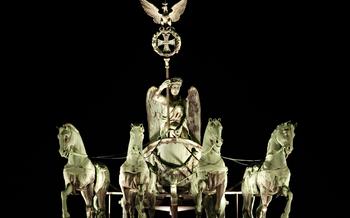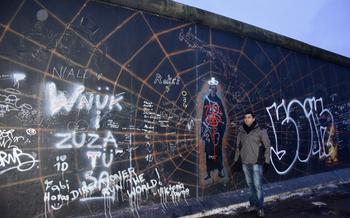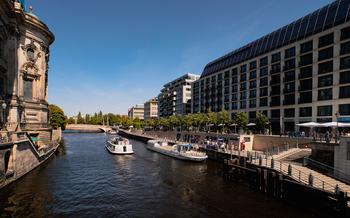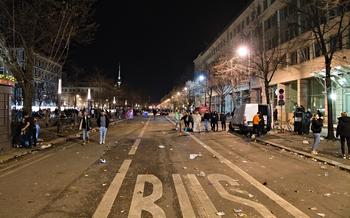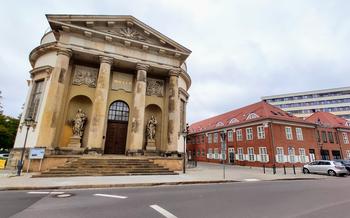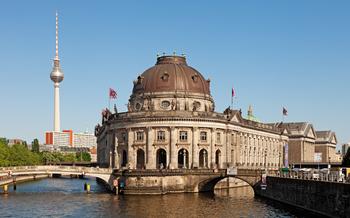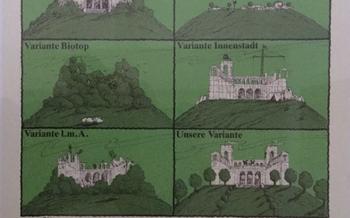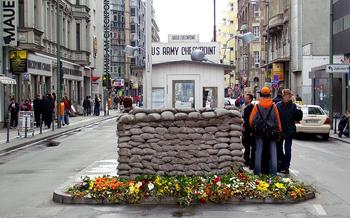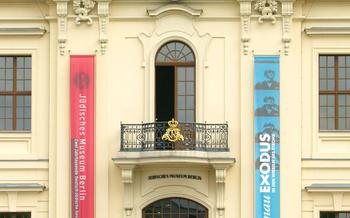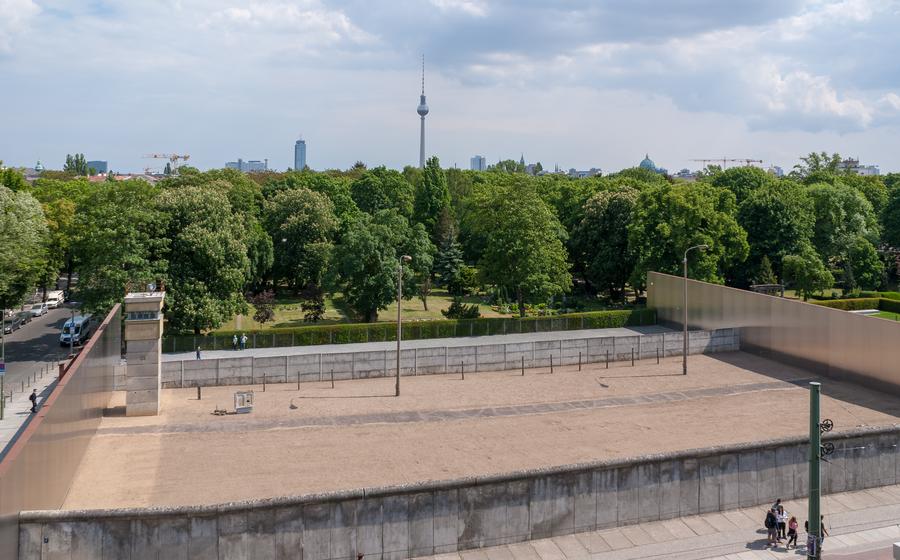
Berlin Wall Memorial
- The Berlin Wall Memorial: A Monument to Division and Freedom
- A Walk Through History: Exploring the Relics of a Divided City
- The Topography of Terror: Unveiling the Legacy of Nazi Repression
- The Stasi Museum: Unveiling the Secrets of East German Surveillance
- The German Historical Museum: A Journey Through German History
- 1 A Comprehensive Exploration of Germany's Past
- 2 A Focus on the Berlin Wall and Reunification
- 3 Guided Tours and Educational Programs
- The Jewish Museum Berlin: A Journey Through Jewish History and Culture
- The Brandenburg Gate: A Symbol of Unity and Division
- A Landmark of German History
- A Symbol of Reunification
- Architectural Masterpiece
- Panoramic Views
- Guided Tours
- The Reichstag Building: A Symbol of German Democracy
- The Charlottenburg Palace: A Glimpse into Prussian Grandeur
- The Berlin Zoological Garden: A Realm of Wildlife Wonders
- Museum Island: A World of Cultural Treasures
- Insider Tip: A Haunting Nighttime Experience
The Berlin Wall Memorial: A Monument to Division and Freedom
The Berlin Wall Memorial, standing as a poignant reminder of a divided city and a symbol of freedom's triumph, holds immense historical significance. Erected in 1961, the infamous Berlin Wall physically and ideologically separated East and West Berlin for over 28 years, becoming a stark symbol of the Cold War era. Today, the memorial site, located along Bernauer Strasse, offers a profound insight into this tumultuous period, commemorating the victims of the division and celebrating the eventual reunification of Germany. The preserved sections of the wall, watchtowers, and memorials serve as a powerful reminder of the struggle for freedom and the resilience of the human spirit in the face of oppression. Personal stories and experiences of those who lived through this era, etched into the very fabric of the memorial, add a deeply moving and human dimension to this historic site.
A Walk Through History: Exploring the Relics of a Divided City
Immerse yourself in the intricate tale of a divided city as you embark on a poignant journey through the Berlin Wall Memorial. Delve into the depths of history, tracing the footsteps of those who lived under the shadow of the imposing barrier. Explore the preserved sections of the wall, remnants of a bygone era, and stand in awe of the watchtowers that once stood as symbols of oppression. Discover the memorials and installations that honor the victims of the division, paying tribute to their resilience and suffering.
Enrich your experience with guided tours or audio guides that provide invaluable insights into the significance of the Berlin Wall. Learn about the political and social forces that shaped this tumultuous period, and gain a deeper understanding of the impact it had on the lives of ordinary people. Through these poignant narratives, you'll gain a profound appreciation for the courage and determination of those who fought for freedom and reunification.
The Topography of Terror: Unveiling the Legacy of Nazi Repression
The Topography of Terror, located in the heart of Berlin, holds a somber yet crucial place in the city's history. It stands on the grounds of the former Gestapo and SS headquarters, serving as a chilling reminder of the Nazi regime's reign of terror.
The site features a series of outdoor and indoor exhibitions, meticulously chronicling the history of Nazi oppression. Through photographs, documents, and interactive displays, visitors gain profound insights into the workings of the Gestapo, SS, and other Nazi security apparatuses.
The Topography of Terror delves into the systematic persecution of individuals and groups targeted by the Nazi regime, including Jews, political dissidents, and other marginalized communities. It also sheds light on the role of forced labor and the horrors of concentration camps.
A highlight of the memorial is the outdoor exhibition, where remnants of the Berlin Wall stand as a tangible symbol of division and oppression. These sections of the wall, once heavily guarded and patrolled, now serve as a poignant reminder of the physical and psychological barriers erected by the totalitarian regime.
Guided tours and educational programs are available to provide visitors with a deeper understanding of the site's history and significance. The Topography of Terror stands as a powerful reminder of the atrocities committed during the Nazi era, serving as a vital space for remembrance, reflection, and education.
The Stasi Museum: Unveiling the Secrets of East German Surveillance
The Stasi Museum: Unveiling the Secrets of East German Surveillance
Delve into the chilling history of the East German secret police, the Stasi, at the Stasi Museum in Berlin. This former headquarters of the feared Stasi provides a unique glimpse into the oppressive surveillance and repression that characterized the German Democratic Republic (GDR).
Interactive Exhibits and Surveillance Methods:
Through interactive exhibits and displays, the museum showcases the Stasi's methods of surveillance and control. Discover the sophisticated techniques used to monitor and suppress dissent, including wiretapping, covert surveillance, and psychological manipulation.
Exploring the Stasi Headquarters:
Explore the former Stasi headquarters, where countless individuals were interrogated, imprisoned, and subjected to psychological torture. The preserved interrogation rooms, prison cells, and offices offer a chilling reminder of the Stasi's reign of terror.
Guided Tours and Educational Programs:
Enhance your understanding of the Stasi's operations and the impact of its surveillance on East German society through guided tours and educational programs. Learn about the personal stories of those who were persecuted and resisted the Stasi's oppressive regime.
A Window into GDR History:
The Stasi Museum serves as a vital reminder of the dark chapter in German history and the importance of upholding individual freedoms and human rights. It offers a unique opportunity to gain insights into the complexities of the GDR's surveillance state and its lasting impact on German society.
The German Historical Museum: A Journey Through German History
1 A Comprehensive Exploration of Germany's Past
The German Historical Museum, situated in the heart of Berlin, embarks visitors on a captivating journey through the annals of German history. From its humble beginnings to the present day, the museum delves into the political, social, and cultural tapestry that has shaped the nation.
2 A Focus on the Berlin Wall and Reunification
Among its extensive exhibits, the museum places special emphasis on the history of the Berlin Wall and the subsequent reunification of Germany. Through artifacts, multimedia displays, and interactive installations, visitors gain a profound understanding of the division, the struggles, and the ultimate triumph that led to the fall of the wall and the unification of East and West Germany.
3 Guided Tours and Educational Programs
To enhance the visitor experience, the German Historical Museum offers guided tours conducted by knowledgeable historians. These tours provide in-depth insights into specific periods or themes, allowing visitors to delve deeper into the complexities of German history. Additionally, educational programs and workshops are available for groups and students, fostering a deeper understanding of Germany's past and its relevance to contemporary society.
The Jewish Museum Berlin: A Journey Through Jewish History and Culture
The Jewish Museum Berlin stands as a testament to the rich history and culture of the Jewish community in Germany. Its poignant exhibits take visitors on a journey through the diverse experiences of Jewish people, from their vibrant traditions to the profound impact of the Holocaust. Through interactive displays and multimedia installations, the museum encourages visitors to engage with and reflect upon the complexities of Jewish history and its enduring legacy.
Guided tours and educational programs delve deeper into the museum's vast collection, shedding light on the contributions of Jewish individuals to German society, as well as the challenges and persecutions they have faced. The museum serves as a powerful reminder of the resilience and strength of the Jewish community, while also promoting understanding and remembrance of the tragic events of the past.
The Brandenburg Gate: A Symbol of Unity and Division
A Landmark of German History
The Brandenburg Gate stands as a testament to Germany's tumultuous history, having witnessed both division and reunification. During the Cold War, it served as a potent symbol of separation, with East Berliners unable to venture beyond its imposing presence. Its iconic Quadriga, a four-horse chariot atop the gate, faced west, seemingly yearning for reunification.
A Symbol of Reunification
In 1989, the fall of the Berlin Wall marked a turning point in history, and the Brandenburg Gate became a symbol of hope and freedom. Thousands of people gathered at the gate, chipping away at the concrete barriers that had divided their city for so long. The gate's reopening symbolized the reunification of East and West Germany, and it remains a poignant reminder of the struggle for freedom.
Architectural Masterpiece
Beyond its historical significance, the Brandenburg Gate is also a stunning architectural masterpiece. Built in the 18th century, it is a testament to the Neoclassical style that was popular at the time. The gate features six Doric columns on each side, supporting a massive entablature and the iconic Quadriga.
Panoramic Views
For a breathtaking perspective of Berlin, visitors can ascend to the top of the Brandenburg Gate. The viewing platform offers panoramic vistas of the city, including the Reichstag Building, the Victory Column, and the Tiergarten park.
Guided Tours
Guided tours of the Brandenburg Gate are available, providing insights into its history, architecture, and significance. Visitors can learn about the gate's role in German history, from its construction to its pivotal role in reunification.
The Reichstag Building: A Symbol of German Democracy
The Reichstag Building, a majestic edifice located in the heart of Berlin, stands as a testament to German democracy and resilience. Initially constructed in the late 19th century, it served as the seat of the German parliament until the Nazi regime's rise to power in 193The building was severely damaged during World War II and lay in ruins for decades, symbolizing Germany's tumultuous past.
In the aftermath of German reunification, the Reichstag Building underwent a comprehensive renovation, blending its historical grandeur with modern architectural elements. The most striking feature of the restored building is its awe-inspiring glass dome, which offers panoramic views of the city and has become an iconic symbol of Berlin.
Visitors to the Reichstag Building can embark on guided tours or explore the interactive exhibits that showcase the history and functioning of the Bundestag, the German parliament. The tours provide insights into the political decision-making processes and offer a glimpse into the workings of a modern democracy.
The Reichstag Building stands as a powerful reminder of Germany's journey from division and destruction to unity and democracy. Its architectural magnificence and historical significance make it a must-visit destination for anyone interested in German history and politics.
The Charlottenburg Palace: A Glimpse into Prussian Grandeur
Nestled amidst the vibrant district of Charlottenburg, the Charlottenburg Palace stands as a testament to the opulence and grandeur of the Prussian era. This sprawling palace, with its sprawling gardens and lavish interiors, is the largest and most magnificent in Berlin.
The brainchild of Sophie Charlotte, the first Queen of Prussia, the palace was built between 1695 and 17Over the centuries, it underwent several expansions and renovations, reflecting the changing tastes and aspirations of its royal occupants. The result is a harmonious blend of architectural styles, from Baroque to Rococo to Neoclassical.
Visitors to the Charlottenburg Palace are greeted by a breathtaking sight: a vast courtyard flanked by two symmetrical wings, adorned with intricate carvings and sculptures. The palace's grand entrance leads to a world of splendor, with opulent state rooms, elegant ballrooms, and private chambers.
The palace's interior is a testament to the exquisite craftsmanship and artistry of the time. The Great Gallery, with its soaring ceiling and mirrored walls, is a masterpiece of Baroque architecture. The Golden Gallery, adorned with gold leaf and glittering chandeliers, is equally impressive.
The Charlottenburg Palace also houses a world-renowned museum, showcasing the rich history and culture of Prussia. The collection umfasst a vast array of artifacts, including furniture, paintings, sculptures, and decorative arts. Visitors can trace the evolution of Prussian history through interactive exhibits and guided tours.
For those seeking a glimpse into the lives of Prussian royalty, the Charlottenburg Palace offers a unique opportunity. The palace's meticulously preserved interiors, including the Queen's bedroom and the King's study, provide a tangible connection to the past.
Whether you're a history buff, an architecture enthusiast, or simply seeking a taste of royal grandeur, the Charlottenburg Palace is a must-visit destination in Berlin.
The Berlin Zoological Garden: A Realm of Wildlife Wonders
Immerse yourself in the captivating realm of wildlife at the Berlin Zoological Garden, one of the oldest and most diverse zoos in the world. Established in 1844, this urban oasis spans 35 hectares and houses over 20,000 animals from every corner of the globe.
Highlights of the Berlin Zoological Garden
Among the zoo's star attractions is the giant panda enclosure, where you can witness these adorable and endangered creatures in their custom-designed habitat. The aquarium, teeming with a kaleidoscope of marine life, takes you on a journey into the depths of the ocean. Marvel at the graceful flight of exotic birds in the sprawling aviary, home to a vibrant array of feathered wonders.
Educational Experiences and Guided Tours
The Berlin Zoological Garden is not just a place of entertainment but also a hub of education and conservation. Guided tours and educational programs provide fascinating insights into the animal kingdom, their habitats, and the importance of protecting our planet's biodiversity.
Insider Tip:
For an unforgettable experience, visit the zoo during feeding time to witness the animals' lively interactions and learn about their unique dietary needs.
Museum Island: A World of Cultural Treasures
Nestled in the heart of Berlin, Museum Island is a UNESCO World Heritage Site that houses five world-renowned museums, each a treasure trove of cultural and historical artifacts. From ancient civilizations to modern masterpieces, the island offers a journey through the annals of human creativity. Highlights include the Pergamon Altar, an awe-inspiring reconstruction of a monumental Greek altar; the Egyptian Museum, showcasing the captivating history of ancient Egypt; and the Bode Museum, housing a remarkable collection of sculptures, Byzantine art, and coins.
With guided tours and audio guides available, Museum Island provides an immersive experience, allowing visitors to delve deep into the stories behind the exhibits. Whether you're fascinated by ancient civilizations, captivated by the grandeur of classical art, or intrigued by the intricacies of Islamic artistry, Museum Island offers a world of cultural wonders to explore. Don't miss the opportunity to immerse yourself in the rich tapestry of human history and creativity that this extraordinary place has to offer.
Insider Tip: A Haunting Nighttime Experience
Visiting the Berlin Wall Memorial at night offers a unique and evocative experience. As darkness envelops the memorial site, the illuminated sections of the wall take on a haunting and ethereal quality. The stark contrast between the dark surroundings and the glowing fragments of the wall creates a powerful and moving atmosphere.
Strolling along the memorial at night allows for a more intimate and reflective experience. The absence of daytime crowds provides an opportunity to contemplate the significance of the wall and its impact on the lives of those who lived in its shadow. The illuminated sections seem to whisper stories of division, oppression, and the eventual triumph of freedom.
For those seeking a deeper understanding of the Berlin Wall's history, guided night tours are available. These tours offer insights into the construction of the wall, the lives of those who lived on either side, and the events leading to its fall. The combination of historical narrative and the evocative nighttime setting creates a memorable and thought-provoking experience.
Whether exploring the memorial independently or with a guided tour, visiting the Berlin Wall Memorial at night is a unique and powerful way to connect with the history of this iconic landmark and gain a deeper appreciation for the struggle for freedom and the triumph of the human spirit.
